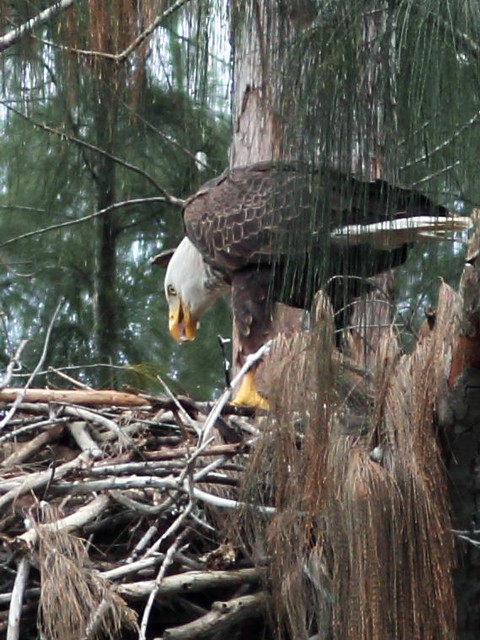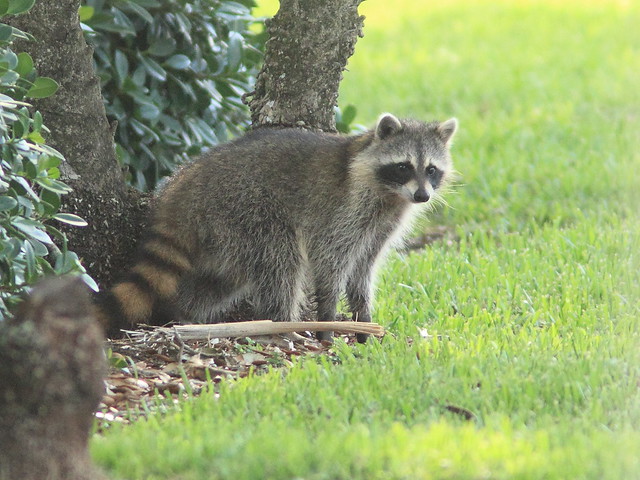Bald Eagles of Broward County, Florida
› ARCHIVED Pembroke Pines OBSERVATIONS & PHOTOS FROM PRIOR NESTING SEASONS
›
ARCHIVED 2015-2016 Observations of Pembroke Pines Bald Eagle Nest BO-002
Blog: Bald Eagles hatch second brood-- BUT on April 11...
Blog: Bald Eagles hatch second brood-- BUT on April 11...
|
Administrator
|
This post was updated on .
LINK TO ORIGINAL BLOG POST
Sunrise over the entrance to our local wetlands: 
The rainy "dry season" has been followed by more typical Spring weather. Morning clouds carry a promise of even more rain: 
As related in this earlier post, Bald Eagles trying for a family again, our local Bald Eagles failed to breed last season during the winter of 2014-2015. The new female of the pair was young and inexperienced and never seemed to exhibit a brooding instinct. Bald Eagles usually breed only once in a season, as the rearing and training of an eaglet takes about 4 to 5 months after the egg is laid until it gains independence. Second broods occasionally occur if a nest or eggs are destroyed early during incubation, and rarely after the loss of eaglets. However, this year, because of unusually severe weather during January and February, 2016, several pairs of Florida's eagles have produced second broods. Our local pair hatched out at least one eaglet but it was probably injured and lost by January 20. This season, Jewel, the female of the pair, laid her first egg on or about December 13, 2015. This egg was expected to hatch in 5 weeks, around January 17. Unfortunately, several severe thunderstorms with winds up to 80 MPH roared through in January, depositing broken branches over the right half of the nest. Since the nest tree is a very limber Australian Pine, the wind surely whipped it about severely. This photo shows damage to nest on the afternoon after the January 17 storm. Adults kept sitting on the nest and tried to move the fallen branches:  On January 19 there was clear photographic evidence that at least one eaglet had survived the storm and was being fed by Pride, but this was the last sign of life in the nest: 
Presumably the newly hatched eaglet sustained injuries which proved fatal, and any other eaglets or eggs were lost. The pair of eagles never abandoned the nest area and the male spent much time sitting in it after the loss of the brood. Then, on January 29 I saw Pride attempting to mate with Jewel:   In mid-February the eagle watchers reported that an adult was persistently sitting deep in the nest, suggesting the possibility that a second clutch of eggs had been deposited. Then, on February 16, another swarm of severe storms swept through, depositing a second and much larger branch on the left side of the nest. Look closely at this photo and see that an adult continued to sit deep despite the new damage:  The eagles stayed on the nest and we feared that the male may have been sitting on one or more infertile eggs, but then both of the pair appeared to be incubating and our hopes were renewed. On March 16 both eagles were seen peering into the nest. They often do this when the first eaglet hatches. On March 17 we received photographic evidence of at least one eaglet in the nest. I took this photo of them feeding a new offspring on March 24th:  
There were actually TWO eaglets seen in the nest by April 2. One eaglet was more active and aggressive: 
The other was smaller and had more natal down: 
The older of the two appeared to be about 2 1/2 weeks old, suggesting it may have hatched on or about March 16. This meant that incubation of the second clutch of eggs began 5 weeks previously, around February 10, just before the second storm blew the other branch down over the nest. They have survived so far despite the adversity. Here they were on April 7:  Pride was guarding the nest and flew down to check on the eaglets: 
As we watched the nest, a family of Raccoons decided to cross the busy highway. We held our breath but they seemed wise enough to wait for a gap in the stream of vehicles: 
One youngster (almost fully grown) was reluctant and lingrered behind: 
After a couple of false starts, it scooted across safely, just ahead of the traffic: 
As I was ready to publish this, I had to add the big "BUT" to the title... I posted this photo in my Bald Eagle Nest Watch FORUM on April 10, showing the older of the two eaglets. I was concerned because its aggressive behavior towards its nest-mate was quite obvious. I assumed that the younger chick was hiding but asked others to look for it and keep tabs on its welfare:  My concerns were justified the very next day, when one of the watchers actually saw and photographed the eaglet being attacked and killed by its sibling. Here is a link to her report of the horrific event. Scroll down to Kathy's post: One eaglet seen in nest -- other has been killed In the event that you cannot bear watching this, here was my response: !t is very sad to learn that the older and more aggressive eaglet killed the younger one. I feared it was being cowed into laying low or even already injured by the older one when I posted my message. Siblicide is one of the eagles' keys to success, as it gives the surviving eaglet a much better chance of becoming an adult. As you may know, the first eaglet is more likely to be a female than a male, and she is larger than the male at all ages. The second is more likely a male, so there is a 1:1 sex balance. The first-hatched, if a female, is more likely to kill a second female, perhaps because it eliminates a competitor while she is still small and weak. A female and male sequence is the most successful combination for survival, maybe because the male learns his place in the hierarchy and does not challenge the female. This also assures a balance between the number of males and females as adults. If the first-hatched is a male the entire brood has less chance of surviving than if the first is a female. Since south Florida eagles developed an instinct to breed much earlier than those up north, there were inherent advantages-- less heat stress on the eaglets and better prey availability when they are growing fastest in February and March. Let's hope that Pride and Jewel can provide for the single eaglet and see her fledge successfully sometime in late summer. LINK TO ORIGINAL BLOG POST
Ken Schneider
Web site: http://rosyfinch.com Blog: http://rosy-finch.blogspot.com Photos: <http://flickr.com/photos/rosyfinch> |
«
Return to ARCHIVED 2015-2016 Observations of Pembroke Pines Bald Eagle Nest BO-002
|
1 view|%1 views
| Free forum by Nabble | Edit this page |

